Our postgraduate students
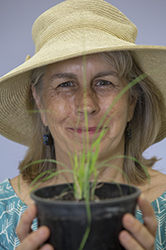 Susanna Bryceson
Susanna Bryceson
How C4 grasses shaped the ecology of eastern Australia
In the Northern Hemisphere, the evolution and rise of C4 grasses led to the creation of savannas and grasslands over 10 million years ago. These grasses sustained large grazing animals — ancient horses, buffalo, deer and others — and brought fire more frequently into landscapes. A mere 3 million years ago, savanna grasses arrived in Australia from Southeast Asia and the experience here was fundamentally different because of our long isolation and the lack of grazing herds.
My research is investigating how these sun-loving grasses could invade a land of trees and shrubs, and what happened when C4 grasses dispersed into ecosystems dominated by flora of Gondwanan origin.
Supervisors: Assoc. Prof. John Morgan and Assoc. Prof. John Webb
 James Buxton
James Buxton
The functional significance of ant colouration
Ants are of immense ecological importance and can be strikingly colourful, ranging from diaphanous yellows to intense reds. I am exploring the colour diversification of ants from a functional perspective in order to identify associations between colour traits and the environment. This will be achieved through a broad variety of approaches including field comparisons, behavioural trials, manipulative experiments, ultrastructural investigations, and visual modelling. This novel approach will potentially enable the development and application of colour-related traits in trait-based ecological studies, as well as contributing to our understanding of animal colouration more generally.
Supervisors: Prof. Heloise Gibb, Dr Kylie Robert, and Prof. Mark Elgar (University of Melbourne)
 Annette Cavangh
Annette Cavangh
Farm-scale Natural Capital Accounting - Plant Biodiversity
With over half of Australia's land used for farming practices, farmers can make an important contribution to the conservation of our natural environment on private land. But all too often, agricultural production has come at the expense of the environment due to market pressures for high yields and quick profits. However, what the market often fails to appreciate, is that a sustainable and productive agricultural system requires a healthy, resilient and biodiverse environment. Natural capital (which includes all natural resources such as soils, water, plants and animals) can benefit farming systems by providing, for example, shelter for crops and livestock, nutrient cycling and water filtration, and habitat for wildlife that contribute to pollination and pest control.
My role in this project is to measure plant biodiversity on fifty farms across south-eastern Australia to determine how plant biodiversity varies with changes in natural capital. These measures will then be integrated into Natural Capital Accounts which will put a value on nature on farms and, in turn, encourage farm management that optimises both natural capital and production, and promote markets for sustainable agriculture.
Supervisors: John Morgan, Jim Radford and Fred Rainsford
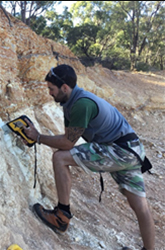 Francesco Colombi
Francesco Colombi
Legacy effects of historical gold mining on floodplains of Victorian rivers
Many river catchments in Victoria were intensively mined during the period 1850 – 1890 leading to wide-scale deposition of mine tailings and changes in river and floodplain geomorphology. My project is directed towards understanding the geochemical changes that have occurred in these tailings deposits on river floodplains, with a particular focus on the upper and lower reaches of the Loddon River.
Elemental composition (using both in-field X-ray Fluorescence and laboratory techniques) and throughout stratigraphy (grain size distribution) of river bank deposits will be employed to differentiate the original (i.e. pre-mining) floodplain surface from more recently deposited tailings. Further investigation of the geochemical changes which have occurred to the mobilised parent minerals through river transport and exposure to the atmosphere will be achieved though semi-quantitative and quantitative XRD of river bank materials and microprobe (EPMA) analysis of arsenic (As)-containing particles. X-ray absorption spectroscopy will also be used to investigate changes to As speciation between source materials and river bank deposits. My work will assist in the future management of these mine tailings, and in understanding the possible toxicological risks to aquatic ecosystems.
Supervisors: Assoc. Prof. Ewen Silvester, Dr Keith White, Dr Darren Baldwin
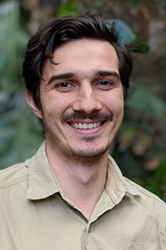 Peter Contos
Peter Contos
Rewilding invertebrates and microbes for biodiversity and ecosystem function
Restoration ecology has historically focused on reconstructing highly visible groups (e.g., plants, vertebrates) whilst ignoring less visible ones, such as invertebrates and microbes. This is problematic as invertebrates and microbes make up the vast bulk of biodiversity and drive many key ecosystem functions. Yet, they are rarely actively reintroduced when they struggle to recolonise restoration sites, limiting ecosystem function and biodiversity in these areas.
My project responds to this shortfall by investigating how we can rewild dispersal-constrained invertebrates and microbes during ecological restoration. My research looks at the efficacy of inoculating restoration sites with litter transplants from biologically rich remnant sites, and its effect on biodiversity and the efficiency of leaf litter breakdown.
Supervisors: Prof. Heloise Gibb and Dr Nick Murphy
 Alicia Dimovski
Alicia Dimovski
The dark side of night-lights: does energy-efficient lighting cause unexpected ecological damage?
It seems ironic that in a bid to combat climate change, and ultimately ‘save the planet’, we are making drastic changes to technology without a full understanding of the hidden ecological damage they might be causing. The introduction of energy-saving lighting, such as energy-efficient LEDs, may be having a great impact on the health of Australian wildlife. Exposure to artificial light can result in a wide range of biological effects on animals including, modified behaviour, disrupted foraging and altered timing of reproduction.
My research aims to identify both the ecological and health impacts of artificial night lighting on targeted groups of Australian mammals. I will then experimentally assess our ability to mitigate these impacts by changing the spectral composition of lights to produce “wildlife-friendly” lighting. Findings from my work will be directly used to generate Australian guidelines regarding lighting design and spectral wavelengths for wildlife-friendly night lighting in sensitive areas.
Supervisors: Dr Kylie Robert, Dr Amy Edwards and Dr Travis Dutka
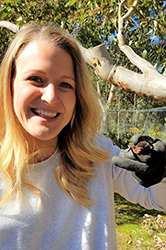 Danielle Eastick
Danielle Eastick
Sex and the city: Investigating the reproductive ecology of a successful urban species, the Gould’s Wattled Bat (Chalinolobus gouldii) in greater Melbourne.
Urban expansion is occurring rapidly worldwide, but our understanding of the effects of urbanisation on wildlife is poor. The success of some species in urban habitats provides valuable insight into evolutionary and selective processes that make them successful. Understanding the life-history strategies around reproduction is key to recognising the drivers associated with a species’ success in changing environments. The Gould’s Wattled Bat (Chalinolobus gouldii) has adapted to become one of the most common microbat species in greater Melbourne, Victoria.
Long-term monitoring of bat-boxes at multiple sites in greater Melbourne has shown that large numbers of Gould’s Wattled Bats occupy boxes year round, providing a unique opportunity to recapture both male and female bats at crucial times throughout the year to document drivers of reproductive success. With reproduction being a period of high energy demand, Gould’s Wattled Bats must overcome the pressures involved in finding adequate resources for themselves and their offspring to ensure the best chance of survival. I aim to build on knowledge gained through the monitoring program by investigating the mating system and reproductive biology of Gould’s Wattled Bats that occupy bat-boxes at multiple sites in greater Melbourne.
Supervisor/s: Dr Kylie Robert, Dr Katherine Harrisson, Dr Amy Edwards
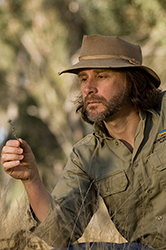 Paul Foreman
Paul Foreman
Multiple evidence of Aboriginal burning in lowland, mesic grassy ecosystems of south-eastern Australia
Just how Aborigines shaped Australia with fire has been fiercely contested by historians and ecologists. There is a need to review and test our understanding of the role of Aboriginal burning in particular environments such as these grasslands. It is argued that the non-alignment of historic grass/tree boundaries with soil patterns, in climatic regions where trees are expected, is evidence of an historic influence of ‘top-down’ processes like fire. And that the clustering of grasslands close to where Aborigines preferred to live, combined with archival accounts of the targeted, purposeful and frequent use of fire by Aborigines, suggests ‘fire–stick farming’ for the production of staple roots was likely instrumental in grassland formation and maintenance. Furthermore, confidence around the role of Aboriginal burning in influencing such vegetation patterns will only result from the acceptance of multiple inferential tests covering a range of multidisciplinary evidence lines, namely: (1) archival benchmarking and palaeoecology; (2) phytoecology, and; (3) ethnology and archaeology.
Supervisors: Assoc. Prof. John Morgan, Assoc. Prof. Pete Green, Assoc. Prof. John Webb
 Attila Gaal
Attila Gaal
Managed Aquifer Recharge - Risks of injection clogging using recycled water in a confined alluvial aquifer
My research focuses on Managed Aquifer Recharge (MAR), which involves a range of methods to recharge water underground such as infiltration basins and injection wells, with important applications in sustainable use and management of natural resources. Although the techniques are well established, the technology is not without its operational problems, one of the most common being the decline of recharge capacity over time due to clogging. The study uses drilling samples, groundwater and recycled water from a MAR scheme in the Melbourne area, as well as other reference samples to provide insights into how clogging may affect MAR schemes.
Supervisor: Assoc. Prof. John Webb
 Estefany Guerra
Estefany Guerra
How different geographic areas trigger contrasting thermal clines on lizard populations
Environmental conditions have a direct effect on the biology of animals, especially vertebrate ectotherms, which are intimately dependent on climate to perform their daily activities. During the last few years, many researchers have focused on studying the influence of environmental temperature shifts on various lizard life history traits, as well on evaluating thermophysiological parameters. Nevertheless, an understanding on how different climatic conditions imposed by geography alter the thermal ecology, physiology and behaviour of lizards is still not completely elucidated for most species. The aim of my project is to analyse the differences on the thermal biology of closely related lizard species, and thus provide new insights into the diverse strategies lizards are implementing to endure the climatic conditions in the area they inhabit. Additionally, it will contribute with valuable thermal ecological data that can be employed to assess the state of lizard populations in the face of climate change.
Supervisor: Dr. Richard Peters
 Clayton Harris
Clayton Harris
Hydrological and vegetation controls upon the Ovens River, southeast Victoria.
My project focuses on terrestrially aged Eucalyptus camaldulensis (River red gum) leaves as a source of bioavailable dissolved organic nitrogen (DON), which I believe has the capacity to act as a valuable nutrient source to in-stream processes, but has received limited attention in the past. After investigating proteins and amino acids from Eucalyptus leaves as a DON source, I have now begun to examine fungi as both a source of and catalyst for the release of DON. I hope that this work will contribute to a greater understanding of freshwater nutrient cycles and food-web dynamics within both floodplain and riverine environments.
Supervisors: Assoc. Prof. Ewen Silvester and Assoc. Prof. Gavin Rees.
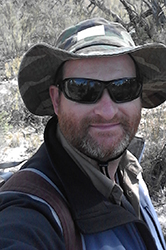 Simon Heyes
Simon Heyes
Early victims or hardy survivors? Assessing climate vulnerability and conservation of plant communities on restricted soils
Climate change poses enormous future challenges to Australia’s biodiversity. Understanding how increasing temperature, more frequent droughts, and predicted increases in fire frequency will affect flora is critical to inform appropriate management actions for some of Australia’s rarest species.
Much of the focus of climate change risk to endangered species include those substantially affected by habitat loss, however, the approaches of translocation or composite provenancing do not apply to edaphic specialist plants growing on restricted soil like limestone or serpentine. The vulnerabilities of these specialised plants to increasing global temperatures may be less about fragmentation and more about increasing environmental (mortality-inducing) stress, and the absence of appropriate habitat within dispersal distance to maintain their climate niche. As such, these species may be ‘early victims’ of climate change. Alternatively, plant species in these communities may be ‘hardy survivors’ – they grow on soils that are typically ‘stressful’ to non-adapted species.
The aim of this project is to investigate if plants on restricted geologies are indeed vulnerable to the effects of climate change, or are they hardy survivors? If edaphic specialist endemics are early victims of climate change, we need to quickly develop on-ground strategies to plan for this increased risk. This might include identifying if novel populations could be established (in the long term) and examining how best to maintain these species in situ (over shorter timescales).
Supervisors: John Morgan, Susan Hoebee and Adam Miller
 Jacinta Humphrey
Jacinta Humphrey
Life in the suburbs: Spatial change in urban bird communities
Increasing urbanisation is a global phenomenon which threatens native biodiversity and contributes to biotic homogenisation. As urban development often occurs close to natural habitats, it has the potential to affect the distribution and abundance of native species, and the overall composition of communities. Knowledge of how urbanisation affects native fauna can assist in planning for more sustainable cities. Jacinta’s project aims to investigate the influence of urban development on bird communities around greater Melbourne. Her study is testing the relative influence of a) extent of tree cover, b) housing density and c) presence of waterways on avian species richness, community composition, and the occurrence of individual species.
Supervisors: Prof. Andrew Bennett and Dr Angie Haslem.
 Duncan Jaroslow
Duncan Jaroslow
Biology, ecology and impact of the introduced Giant pine scale (Marchalina hellenica) on Pinus radiata in Australia.
Giant pine scale is a sap sucking insect native to pine forests of the eastern Mediterranean region, where it feeds primarily on native pine species. Recently, giant pine scale was detected in Melbourne and Adelaide, where it has been feeding on the novel host Pinus radiata, an economically significant tree for Australian timber production. Giant pine scale usually reproduces parthenogenically and secretes thick cotton-like wax. These traits have rendered conventional eradication ineffective, yet effective management strategies are needed to mitigate its impact. The biology and ecology of this insect in Australia is poorly understood, which limits the capacity to predict its pest potential or likelihood of management using biological control.
My Forest and Wood Products Australia (FWPA) funded project seeks to understand the nature of the Giant pine scale’s biology, life history and ecology on its new host and in the Australian environment, to quantify its actual and potential impact on native ecosystems and timber production in Australia, and to provide insights into adaptive strategies and insect-plant interactions of scale insects more broadly.
Supervisors: Assoc. Prof. Martin Steinbauer, Assoc. Prof. Paul Cunningham (Agriculture Victoria) and Dr Angus Carnegie (NSW Department of Primary Industries).
 Karen Kapteinis
Karen Kapteinis
The Geomorphology of the Alluvial Megafans of the Northern Victorian Plains
Low-angle alluvial megafans have been observed to extend from the Victorian highlands northward into the Murray Basin. Megafans are defined as large fluvial features formed when a stream exits a mountain range onto a flat plain. Intermittent, high-volume discharge events gradually build up the surface of the fan by depositing successive layers of sediment on the surface. This depositional pattern is facilitated by a network of distributary channels that feeds the different areas of the fan. Due to their very low angle (no more than 0.0009°) and low relief, these features had previously not been identified as alluvial megafans and were instead classified as general channel and flood sediments of the Shepparton Formation, a Pliocene-Holocene aged floodplain formation. Three megafans in particular will be the main focus of this study, and are located along the Loddon River, Campaspe River and Bullock Creek. The aim of my research is to understand the past and present geomorphological processes that contributed to the formation of these megafans. By completing this research, a better understanding of the flood processes of the Victorian Riverine plains will be achieved, in addition to understanding the formation processes of low angle temperate alluvial megafans in a mid-latitude context.
Supervisors: Assoc. Prof. John Webb, Dr Susan White, Dr Gresley Wakelin-King
 Rhys Makdissi
Rhys Makdissi
Managing fire for bird conservation in a semi-arid landscape
Fire is commonly used as a management tool to promote and conserve biodiversity in many global ecosystems, particularly in fire-prone landscapes where contemporary anthropogenic disturbances and climatic changes have altered natural fire regimes. However, the general application of fire through these practices is unlikely to benefit all species equally, as post-fire responses can be highly variable both within a species throughout its geographic range, and also between different species in an ecosystem. To achieve more sustainable management outcomes, it is necessary to increase our understanding of how individual species respond to long-term ecological changes caused by burning, especially when under the influence of altered fire regimes.
My research examines the influence of fire and its habitat-altering effects on the distribution and ecology of different bird species and larger avian communities in the Victorian Mallee. Through this work, I hope to improve our current understanding of the immediate and long-term impacts of fire on these species and contribute to the development of more targeted fire management strategies that promote and conserve biodiversity in the region.
Supervisors: Prof. Michael Clarke, Dr. Jim Radford, Prof. Andrew Bennet & Dr. Simon Verdon
 Shauni Omond
Shauni Omond
Sleep evolution: pharmacological, electrophysiological, biochemical and comparative perspectives.Sleep is a much-studied behaviour across animals, with humans spending roughly one-third of their lives in this vulnerable state. But where did it all start? My research looks at the evolutionary origins of sleep. My main research group is platyhelminth flatworms – a phylum that appeared 800 million years ago - to determine whether the processes that maintain and regulate sleep in humans is shared between distantly-related animals. To do this, I use a combination of behavioural, pharmacological, biochemical, and electrophysiological techniques. I will also be using the flatworms' extraordinary ability to regenerate their complete brain to study the potential differences between naïve and ‘lab-grown’ sleep behaviour. The final part of my PhD will be to characterise sleep in sea cucumbers, close relatives of the Chordate phylum, to further understand the evolutionary pathway of sleep. Collectively, these studies will provide insight into when, why, and how sleep first appeared.
Supervisors: Dr John Lesku, Assoc. Prof. Martin Steinbauer, Dr Matthew Hale and Assoc. Prof. Bruno van Swinderen (Queensland Brain Institute - University of Queensland).
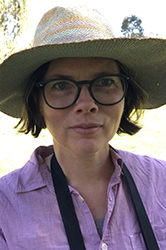 Nina Roberts
Nina Roberts
Ecological lessons from Djaara women returning food plants to Country
Despite the obvious overlap between aspirations of First Nations Australians to heal Country and the goals of restoration ecologists, there have been few projects seeking to co-produce knowledge on healing/restoration between scientists and Traditional Custodians in SE Australia.
My project, which is part of a research partnership between La Trobe University and Dja Dja Wurrung Clans Enterprises, asks how important women’s cultural plants can be re-established or made more abundant through culturally informed practices on Dja Dja Wurrung Country. I am working closely with a Dja Dja Wurrung Women’s Knowledge Group using a participatory action research method.
In addition to building knowledge of the factors influencing (re)establishment success of the plants, I aim to use the unique opportunity of this collaboration and the participatory method to explore the dimensions of culturally informed ecological research. There are likely wider implications for informing ecological restoration (healing Country) in a post-colonial landscape.
Supervisors: John Morgan, Jim Radford, Susan Lawrence and Julie Andrews (plus external supervision from Aunty Marilyne Nicholls and Nathan Wong of DDWCAC Enterprises)
 Rakhshan Roohi
Rakhshan Roohi
Remote Sensing evapotransiration in Blue Gum plantations
Rakhshan is modelling for remote sensing evapotranspiration estimate to constrain groundwater contributions to catchment water balances in western Victoria. Evapotranspiration is an essential component of the hydrological balance. For field measurements of ET, various techniques are used. Although point data can be extrapolated, the reliability over large areas is uncertain. To overcome this limitation, a Surface Energy Balance Algorithms for Rainfed Agriculture (SEBARA) is developed and the satellite data, at a spatial resolution of 30 x 30m, is used to estimate the spatial pattern of evapotranspiration.
Extensive blue gum (Eucalyptus globulus) plantations have been established in SW Victoria which have impacted the groundwater resources. Her project will help to understand the impact of land use shift on the available water resources.
Supervisor: Assoc. Prof. John Webb
 Emily Scicluna
Emily Scicluna
Using personality and cognitive assessment of individuals as a conservation tool for improving reintroduction/translocation success.
Species extinction has reached crisis point globally and the need to develop effective and efficient ways of managing remaining endangered populations is greater than ever. Captive breeding and reintroduction has been identified as a key approach in conservation, however the success of such programs is debatable with survival after release being low. The choice of candidates for release is often based on age, sex and health status, however, there is growing recognition that an individual’s behavioural type is related to fitness and hence may be important to survival success. While the existence of different personality traits within and between animal populations has been relatively well established, the application of this variation to reintroduction programs has been neglected.
The key aim of my PhD is to establish if personality and cognitive assessment of individuals can be used as a conservation tool for improving reintroduction/translocation success. Findings from my research will inform recovery teams on the release of individuals with traits linked to increased survival.
Supervisors: Assoc. Prof. Pete Green, Dr Marissa Parrott (Zoos Victoria), and Dr Richard Peters
 Campbell Van Praagh
Campbell Van Praagh
The White Hills Gravel throughout Central Victoria
The White Hills Gravel is an Early Tertiary fluvial gravel, deposited some 55 – 68 million years ago, that is preserved as remnants throughout much of northwestern and north-central Victoria. The distribution and properties of these river gravels suggest that they were deposited during high-energy chaotic floods that affected a large area across Victoria. Campbell’s research aims to improve upon the previous mapping of the White Hills Gravel across these areas, and reconstruct the likely pathways of the ancient rivers that deposited them. Campbell will also interpret aspects of the Early Tertiary landscape and climate of Victoria through analysis of the gravels, and endeavour to identify less-prominent faults within the landscape that may have been missed within previous geological mapping. The project involves a significant component of field work, and the use of GIS software to store and analyse the collected data.
Supervisors: Assoc. Prof. John Webb, Dr Susan White
 Stanislaw Wawrzyczek
Stanislaw Wawrzyczek
The evolution of mammal pollination in the south-west Australian biodiversity hotspot and its vulnerability to landscape modification
Mammals are known to contribute to pollination of diverse plant genera across Australia. However, there is little evidence for pollination systems specialized on mammal pollination. Many of the western Australian banksias in the Dryandra series have unusual prostrate inflorescences that appear adapted to pollination by flightless mammals, particularly, the honey possum. My research will test for specialisation on mammal pollination in members of Dryandra using a combination of methods of behavioural ecology, population genetics, species observation and exclusion experiments, and phylogenetic analyses. I will investigate the resilience of this pollination strategy to landscape modification by identifying any environmental threats to the continued interaction of honey possums and dryandras.
The expected outcomes of this study will be improved understanding of the evolution of mammal pollination of dryandras. The study will also aid land managers through better understanding of the key threats of this remarkable ecological interaction.
Supervisors: Dr Ryan Phillips, Dr Susan Hoebee, Dr Rob Davies (Edith Cowan University, WA)
